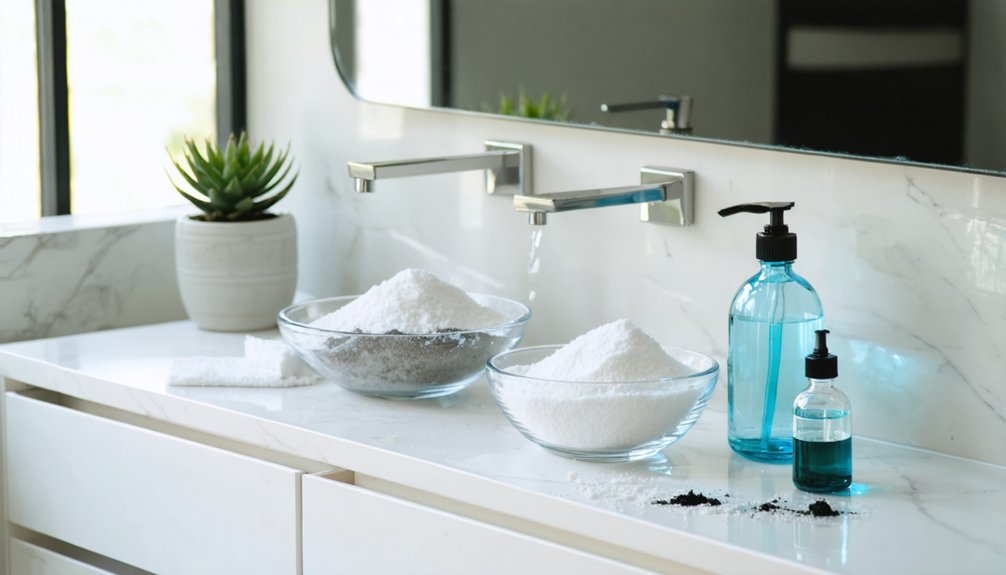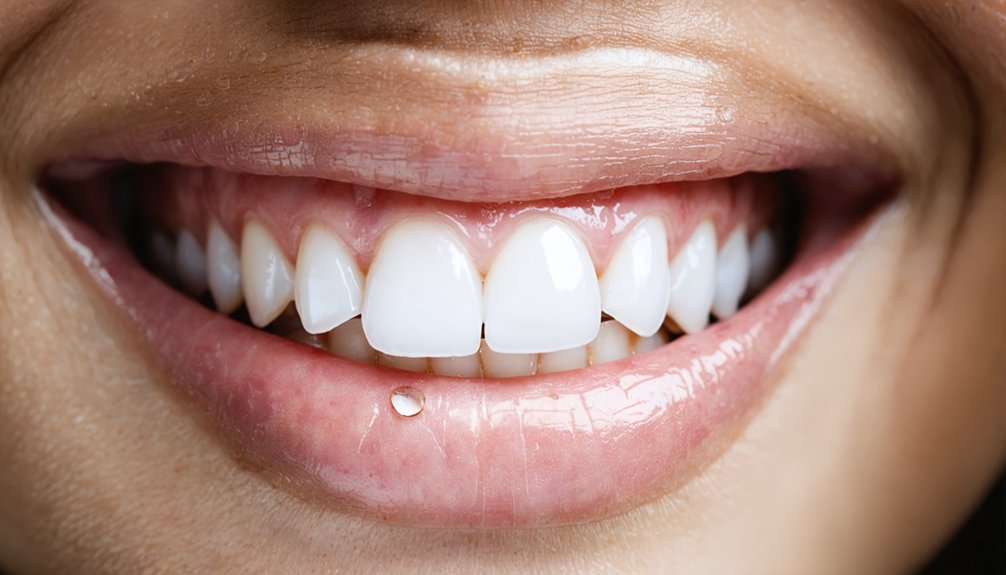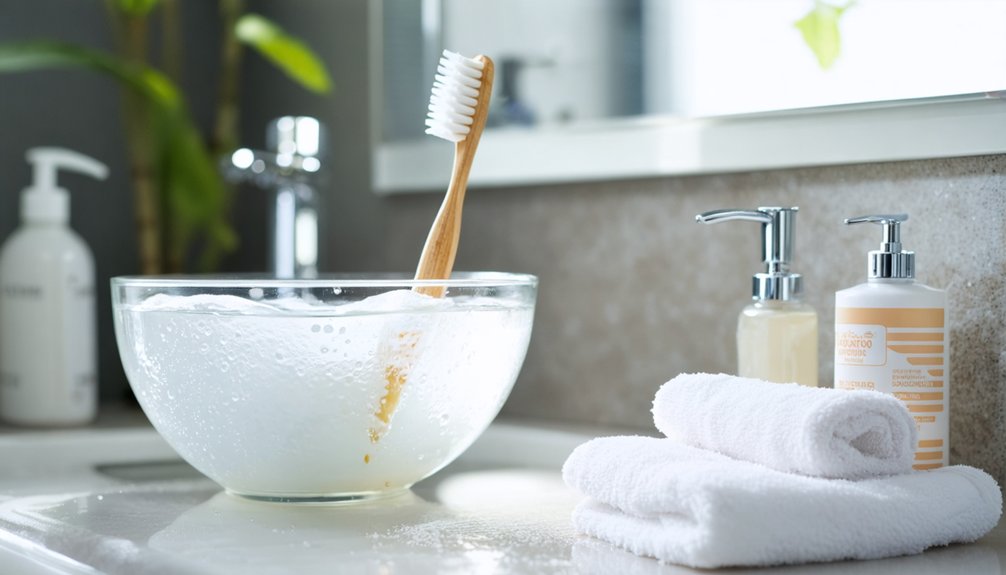For safe and effective teeth whitening at home, use hydrogen peroxide at 3% concentration or carbamide peroxide at 10%. Always brush and floss thoroughly before applying small amounts of whitening gel to clean, custom-fitted trays. Space treatments 48-72 hours apart and limit sessions to 7-14 per cycle. Combat sensitivity by using desensitizing toothpaste and avoiding extreme temperatures post-treatment. Following proper protocols and concentrations will help you achieve professional-level results while protecting your dental health.
Key Takeaways
- Use 3% hydrogen peroxide concentration for safe at-home whitening, or up to 10% carbamide peroxide products for gentle effectiveness.
- Clean teeth thoroughly before application and apply small amounts of whitening gel to avoid gum irritation.
- Space treatments 48-72 hours apart, limiting sessions to 7-14 treatments per cycle with no more than 20 annually.
- Mix hydrogen peroxide with baking soda to create a gentle whitening paste for maintenance between treatments.
- Stop treatment immediately if experiencing sharp pain or persistent sensitivity, and consult a dentist for professional guidance.
Understanding Safe Hydrogen Peroxide Concentrations
When it comes to teeth whitening with hydrogen peroxide, understanding safe concentrations is essential for avoiding damage to your teeth and gums. For safe usage, stick to store-bought solutions containing around 3% hydrogen peroxide, which aligns with concentration guidelines recommended by dental professionals. Custom-fitted mouth guards from your dentist provide the safest application method for hydrogen peroxide whitening.
Safe teeth whitening starts with proper peroxide levels – dental experts recommend 3% solutions for effective at-home treatments without risking damage.
You’ll find that carbamide peroxide products, which break down into hydrogen peroxide, are safe to use at concentrations up to 10% – equivalent to approximately 3.6% hydrogen peroxide.
While professional treatments may use concentrations between 35-50%, these should only be administered under dental supervision. To protect your oral health, avoid higher concentrations for home use, as they can cause enamel damage, sensitivity, and gum irritation. Long-term exposure to hydrogen peroxide can cause inflammation of oral tissues.
Remember that effective whitening doesn’t require dangerous concentrations; lower percentages can achieve noticeable results when used properly.
Professional vs. Home Whitening Methods
Although both professional and home whitening methods can effectively brighten your smile, they differ markedly in their approach, concentration levels, and outcomes.
Professional treatments utilize higher peroxide concentrations (35-40%) for rapid results but may increase tooth sensitivity and enamel effects. The American Dental Association recommends professional supervision for these higher concentration products. Home kits offer gentler whitening with lower concentrations (3-10%) and better safety measures, though results take longer. Store-bought peroxide typically contains a 3% concentration for safe at-home use.
- Professional treatments provide custom-fitted trays and expert supervision but require office visits and higher costs.
- Home kits offer flexibility in application duration and product accessibility at lower prices, requiring careful adherence to instructions.
Results variability depends on patient preferences and commitment, with studies showing comparable whitening effectiveness between methods when properly used.
Consider combining both approaches for the best results, starting with professional treatment followed by home maintenance to preserve your brightened smile.
Step-by-Step Application Guide
Successful hydrogen peroxide teeth whitening requires proper application techniques and careful adherence to safety protocols. Start by thoroughly brushing and flossing your teeth to guarantee a clean surface.
For optimal whitening results, always prepare teeth with thorough brushing and flossing, and strictly follow safety guidelines throughout the process.
When using custom-fitted trays, verify they’re clean and completely dry before gel placement. Apply a small amount of whitening gel to the front surfaces of the tray, avoiding overfill to protect your gums.
For alternative methods, you can create a mouthwash by mixing equal parts 3% hydrogen peroxide and water, or prepare a whitening paste using hydrogen peroxide and baking soda. Professional products contain up to ten percent hydrogen peroxide for more effective whitening results.
Whichever technique you choose, maintain strict wearing times and follow post-treatment care. For optimal results, consider in-chair treatments with a dental professional for immediate whitening effects. Remember to avoid staining beverages for at least two hours after treatment and continue using fluoride toothpaste to protect your enamel’s integrity.
Preventing Side Effects and Sensitivity
To minimize discomfort during teeth whitening, you’ll need to carefully manage peroxide concentrations and exposure times. Choose products with lower concentrations, ideally no more than 3.5% hydrogen peroxide for at-home use. Professional in-office bleaching can deliver faster results using higher peroxide concentrations under dental supervision.
For effective sensitivity management, incorporate desensitizing products before and after treatment. The exposure of microtubules during whitening is what typically causes temporary tooth sensitivity.
- Use desensitizing toothpaste containing potassium nitrate or stannous fluoride several days before and after whitening
- Avoid extreme temperatures for 24-48 hours post-treatment by consuming room temperature foods and beverages
- Monitor your sensitivity levels and adjust treatment frequency accordingly, pausing if discomfort becomes significant
If you experience persistent sensitivity, consult your dentist immediately. They can evaluate your teeth’s condition and recommend appropriate modifications to your whitening protocol.
Remember that while mild sensitivity is common, it’s typically temporary and manageable with proper precautions.
Best Practices for Long-Term Results
Maintaining your whitening results requires a thorough approach that combines proper oral hygiene, lifestyle modifications, and strategic touch-up treatments.
Focus on diligent plaque control and use whitening toothpaste containing low-dose peroxide to prevent stain redeposition.
Make essential dietary changes by limiting exposure to chromogens like coffee and red wine, and rinse your mouth with water after consuming staining agents.
Creating a baking soda paste with hydrogen peroxide can provide gentle touch-up maintenance between treatments.
Consider monthly at-home maintenance with custom trays or strips containing appropriate peroxide concentrations.
Schedule regular professional cleanings to remove stubborn surface stains and calculus.
Your lifestyle habits greatly impact long-term success – avoid tobacco and minimize acidic beverages. Be mindful that intrinsic stains from medications or aging may require professional intervention.
Under professional supervision, you’ll receive customized recommendations for touch-up treatments that balance effectiveness with enamel protection, ensuring your bright smile lasts longer.
Timing and Frequency of Treatments
While achieving a brighter smile is desirable, proper timing and frequency of hydrogen peroxide treatments are crucial for both safety and effectiveness. Your whitening schedule should follow recommended treatment intervals to protect your enamel and minimize sensitivity while maximizing results.
Safe and effective tooth whitening requires careful timing of treatments to protect enamel while achieving optimal brightness.
- Space your treatments 48-72 hours apart during initial whitening cycles to allow tissue recovery while maintaining efficacy.
- Limit at-home whitening to 7-14 sessions per cycle, with no more than 20 sessions annually.
- Schedule professional in-office treatments every 6-12 months for ideal maintenance.
Remember to adjust your treatment intervals based on tooth sensitivity. Higher concentration gels require shorter application times, while gradual whitening with longer intervals between sessions can achieve comparable results with improved comfort.
Following these guidelines helps guarantee safe, lasting results without compromising your dental health.
Combining With Other Whitening Agents

Effective teeth whitening often involves strategic combinations of multiple whitening agents to achieve ideal results. When combining agents, you’ll find that hydrogen peroxide works synergistically with several common whitening substances.
Mixing 3% hydrogen peroxide with baking soda creates a safe, effective paste that provides both chemical bleaching and mechanical stain removal. Apply this mixture gently for no more than 2 minutes, once or twice weekly.
For sustained whitening, consider products containing carbamide peroxide, which breaks down into hydrogen peroxide gradually. You can enhance results by using peroxide-containing toothpaste as part of your daily routine.
Just make certain you’re using ADA-approved products and following recommended concentrations to protect your enamel and prevent sensitivity while maximizing effectiveness compared to single-agent treatments.
Signs to Stop or Seek Professional Help
Safety remains paramount when using hydrogen peroxide for teeth whitening, and recognizing warning signs can prevent serious complications.
Proper precautions and awareness of warning signs are essential safeguards when whitening teeth with hydrogen peroxide treatments.
You’ll need to monitor closely for sensitivity signals and gum irritation during and after treatment.
Stop whitening immediately and consult a dental professional if you experience:
- Sharp pain, extreme discomfort, or sensitivity that persists beyond a few days
- Gum redness, swelling, bleeding, or visible lesions
- Rough tooth surfaces, spotting, or noticeable enamel thinning
Watch for uneven whitening results or patchy coloration, as these can indicate improper application or underlying dental issues.
If you’re using over-the-counter products, you’re at higher risk for complications due to lack of professional oversight.
Don’t continue treatment if you notice any adverse reactions – prioritize your oral health over aesthetic goals.
Maintaining Your Whiter Smile

Once you’ve achieved your desired level of whiteness, maintaining those results requires consistent preventive measures and good oral hygiene habits.
Your dietary choices greatly impact whitening maintenance, so limit coffee, tea, red wine, and acidic beverages that can stain or erode enamel. Rinse your mouth immediately after consuming staining substances.
Continue your oral care routine with whitening toothpaste containing hydrogen peroxide and brush twice daily at a 45-degree angle. Use your custom-fitted whitening trays as prescribed by your dentist for periodic touch-ups.
Don’t forget to floss daily and schedule regular dental cleanings. Support your results by eating raw fruits and vegetables that naturally clean teeth, while maintaining a calcium-rich diet to strengthen enamel and prevent discoloration.
Common Mistakes to Avoid
While maintaining your whiter smile requires diligence, avoiding common mistakes can make the difference between successful whitening and potential complications. One of the most prevalent whitening myths is that all products work equally well for everyone. To avoid common errors and protect your oral health, you’ll need to be strategic in your approach.
- Never proceed with whitening treatments without consulting your dentist first, especially if you have restorations or existing dental issues.
- Don’t exceed recommended application times or concentrations of hydrogen peroxide, as this can lead to sensitivity and enamel damage.
- Avoid consuming staining foods and beverages immediately after treatment, and maintain proper oral hygiene throughout your whitening process.
Understanding these pitfalls will help guarantee your teeth whitening journey is both safe and effective while minimizing potential risks.
Frequently Asked Questions
Can I Whiten My Teeth While Wearing Braces or Dental Crowns?
You shouldn’t attempt braces whitening, as it causes uneven results. While you can whiten natural teeth around crowns, crown safety is important—the crowns won’t change color. Wait until braces removal.
Does Hydrogen Peroxide Whitening Work on Tetracycline-Stained Teeth?
While you’d expect tetracycline stains to surrender easily to whitening, they’re quite stubborn. You’ll see limited effectiveness with hydrogen peroxide, though professional-strength treatments can achieve gradual improvement under dental supervision.
Will Whitening Affect the Bonding Material Used in Dental Fillings?
You can’t whiten bonding materials used in dental fillings. The whitening effects will only work on natural teeth, potentially creating a noticeable color mismatch between your fillings and surrounding teeth.
Can Children or Teenagers Safely Use Hydrogen Peroxide for Teeth Whitening?
You shouldn’t use hydrogen peroxide whitening on children under 14-16 years old due to safety guidelines. Wait until your teen meets age restrictions and consult a dentist for professional supervision.
Does Taking Certain Medications Affect Hydrogen Peroxide Whitening Results?
Like a stubborn ink stain, medication-related tooth discoloration can resist hydrogen peroxide’s effects. While there aren’t direct medication interactions, you’ll need professional guidance to assess dosage considerations and treatment alternatives.
References
- https://pubmed.ncbi.nlm.nih.gov/23846062/
- https://www.medicalnewstoday.com/articles/326148
- https://pmc.ncbi.nlm.nih.gov/articles/PMC9915942/
- https://www.ada.org/resources/ada-library/oral-health-topics/whitening
- https://www.urmc.rochester.edu/news/publications/health-matters/diy-teeth-whitening-too-good-to-be-true
- https://health.clevelandclinic.org/is-teeth-whitening-safe
- https://www.hicksdentalgroup.com/whiten-teeth-with-hydrogen-peroxide/
- https://dentalsmilesatdacula.com/is-hydrogen-peroxide-safe-for-teeth-whitening/
- https://www.colgate.com.au/oral-health/teeth-whitening/is-hydrogen-peroxide-safe-for-teeth
- https://www.healthline.com/health/hydrogen-peroxide-teeth-whitening



